Li Niu
$\text{G}^2$RPO: Granular GRPO for Precise Reward in Flow Models
Oct 02, 2025Abstract:The integration of online reinforcement learning (RL) into diffusion and flow models has recently emerged as a promising approach for aligning generative models with human preferences. Stochastic sampling via Stochastic Differential Equations (SDE) is employed during the denoising process to generate diverse denoising directions for RL exploration. While existing methods effectively explore potential high-value samples, they suffer from sub-optimal preference alignment due to sparse and narrow reward signals. To address these challenges, we propose a novel Granular-GRPO ($\text{G}^2$RPO ) framework that achieves precise and comprehensive reward assessments of sampling directions in reinforcement learning of flow models. Specifically, a Singular Stochastic Sampling strategy is introduced to support step-wise stochastic exploration while enforcing a high correlation between the reward and the injected noise, thereby facilitating a faithful reward for each SDE perturbation. Concurrently, to eliminate the bias inherent in fixed-granularity denoising, we introduce a Multi-Granularity Advantage Integration module that aggregates advantages computed at multiple diffusion scales, producing a more comprehensive and robust evaluation of the sampling directions. Experiments conducted on various reward models, including both in-domain and out-of-domain evaluations, demonstrate that our $\text{G}^2$RPO significantly outperforms existing flow-based GRPO baselines,highlighting its effectiveness and robustness.
Unsupervised Exposure Correction
Jul 23, 2025Abstract:Current exposure correction methods have three challenges, labor-intensive paired data annotation, limited generalizability, and performance degradation in low-level computer vision tasks. In this work, we introduce an innovative Unsupervised Exposure Correction (UEC) method that eliminates the need for manual annotations, offers improved generalizability, and enhances performance in low-level downstream tasks. Our model is trained using freely available paired data from an emulated Image Signal Processing (ISP) pipeline. This approach does not need expensive manual annotations, thereby minimizing individual style biases from the annotation and consequently improving its generalizability. Furthermore, we present a large-scale Radiometry Correction Dataset, specifically designed to emphasize exposure variations, to facilitate unsupervised learning. In addition, we develop a transformation function that preserves image details and outperforms state-of-the-art supervised methods [12], while utilizing only 0.01% of their parameters. Our work further investigates the broader impact of exposure correction on downstream tasks, including edge detection, demonstrating its effectiveness in mitigating the adverse effects of poor exposure on low-level features. The source code and dataset are publicly available at https://github.com/BeyondHeaven/uec_code.
Object Placement for Anything
Apr 16, 2025Abstract:Object placement aims to determine the appropriate placement (\emph{e.g.}, location and size) of a foreground object when placing it on the background image. Most previous works are limited by small-scale labeled dataset, which hinders the real-world application of object placement. In this work, we devise a semi-supervised framework which can exploit large-scale unlabeled dataset to promote the generalization ability of discriminative object placement models. The discriminative models predict the rationality label for each foreground placement given a foreground-background pair. To better leverage the labeled data, under the semi-supervised framework, we further propose to transfer the knowledge of rationality variation, \emph{i.e.}, whether the change of foreground placement would result in the change of rationality label, from labeled data to unlabeled data. Extensive experiments demonstrate that our framework can effectively enhance the generalization ability of discriminative object placement models.
The Devil is in the Prompts: Retrieval-Augmented Prompt Optimization for Text-to-Video Generation
Apr 16, 2025Abstract:The evolution of Text-to-video (T2V) generative models, trained on large-scale datasets, has been marked by significant progress. However, the sensitivity of T2V generative models to input prompts highlights the critical role of prompt design in influencing generative outcomes. Prior research has predominantly relied on Large Language Models (LLMs) to align user-provided prompts with the distribution of training prompts, albeit without tailored guidance encompassing prompt vocabulary and sentence structure nuances. To this end, we introduce \textbf{RAPO}, a novel \textbf{R}etrieval-\textbf{A}ugmented \textbf{P}rompt \textbf{O}ptimization framework. In order to address potential inaccuracies and ambiguous details generated by LLM-generated prompts. RAPO refines the naive prompts through dual optimization branches, selecting the superior prompt for T2V generation. The first branch augments user prompts with diverse modifiers extracted from a learned relational graph, refining them to align with the format of training prompts via a fine-tuned LLM. Conversely, the second branch rewrites the naive prompt using a pre-trained LLM following a well-defined instruction set. Extensive experiments demonstrate that RAPO can effectively enhance both the static and dynamic dimensions of generated videos, demonstrating the significance of prompt optimization for user-provided prompts. Project website: \href{https://whynothaha.github.io/Prompt_optimizer/RAPO.html}{GitHub}.
Light-A-Video: Training-free Video Relighting via Progressive Light Fusion
Feb 12, 2025
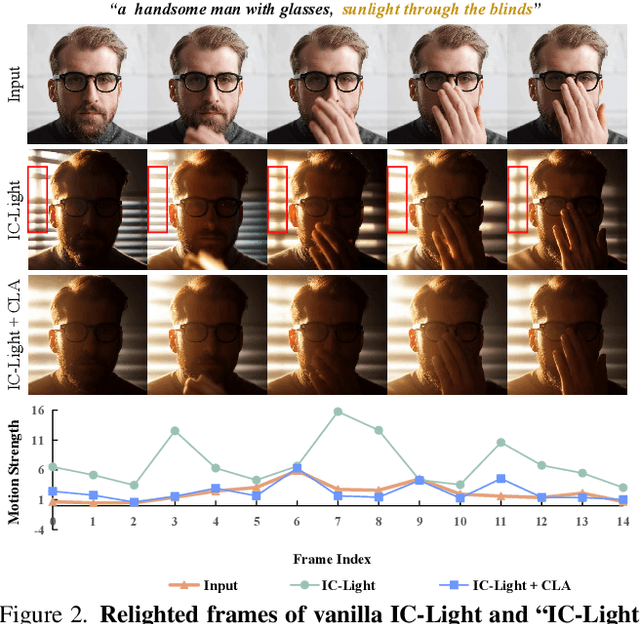
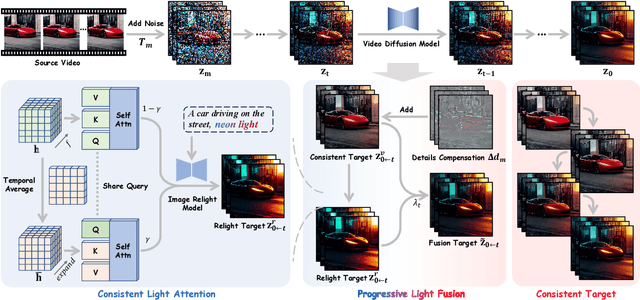
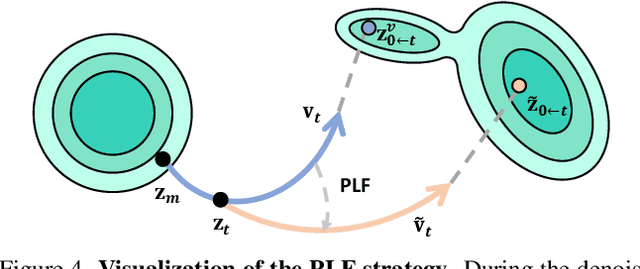
Abstract:Recent advancements in image relighting models, driven by large-scale datasets and pre-trained diffusion models, have enabled the imposition of consistent lighting. However, video relighting still lags, primarily due to the excessive training costs and the scarcity of diverse, high-quality video relighting datasets. A simple application of image relighting models on a frame-by-frame basis leads to several issues: lighting source inconsistency and relighted appearance inconsistency, resulting in flickers in the generated videos. In this work, we propose Light-A-Video, a training-free approach to achieve temporally smooth video relighting. Adapted from image relighting models, Light-A-Video introduces two key techniques to enhance lighting consistency. First, we design a Consistent Light Attention (CLA) module, which enhances cross-frame interactions within the self-attention layers to stabilize the generation of the background lighting source. Second, leveraging the physical principle of light transport independence, we apply linear blending between the source video's appearance and the relighted appearance, using a Progressive Light Fusion (PLF) strategy to ensure smooth temporal transitions in illumination. Experiments show that Light-A-Video improves the temporal consistency of relighted video while maintaining the image quality, ensuring coherent lighting transitions across frames. Project page: https://bujiazi.github.io/light-a-video.github.io/.
MureObjectStitch: Multi-reference Image Composition
Nov 12, 2024



Abstract:Generative image composition aims to regenerate the given foreground object in the background image to produce a realistic composite image. In this work, we propose an effective finetuning strategy for generative image composition model, in which we finetune a pretrained model using one or more images containing the same foreground object. Moreover, we propose a multi-reference strategy, which allows the model to take in multiple reference images of the foreground object. The experiments on MureCOM dataset verify the effectiveness of our method.
DomainGallery: Few-shot Domain-driven Image Generation by Attribute-centric Finetuning
Nov 07, 2024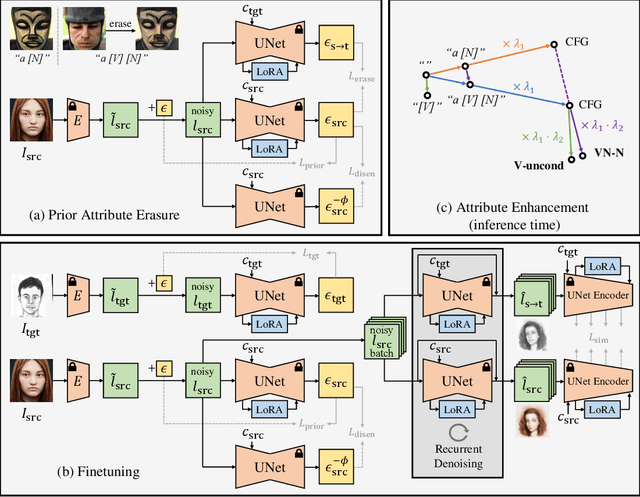
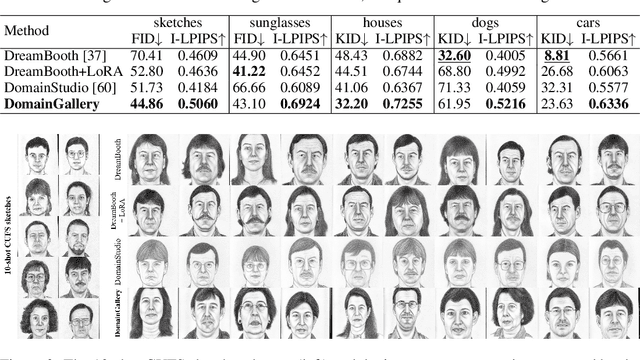
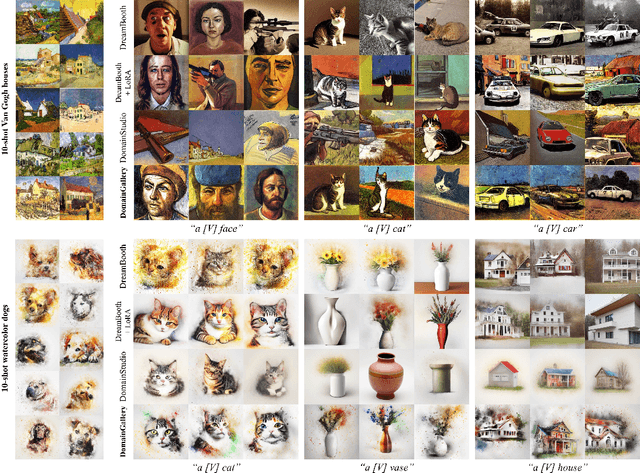
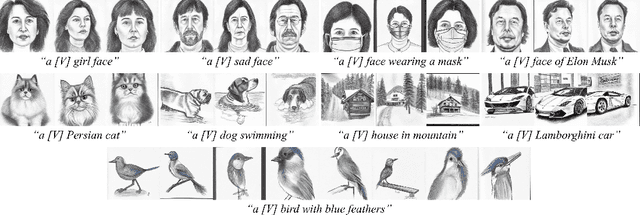
Abstract:The recent progress in text-to-image models pretrained on large-scale datasets has enabled us to generate various images as long as we provide a text prompt describing what we want. Nevertheless, the availability of these models is still limited when we expect to generate images that fall into a specific domain either hard to describe or just unseen to the models. In this work, we propose DomainGallery, a few-shot domain-driven image generation method which aims at finetuning pretrained Stable Diffusion on few-shot target datasets in an attribute-centric manner. Specifically, DomainGallery features prior attribute erasure, attribute disentanglement, regularization and enhancement. These techniques are tailored to few-shot domain-driven generation in order to solve key issues that previous works have failed to settle. Extensive experiments are given to validate the superior performance of DomainGallery on a variety of domain-driven generation scenarios. Codes are available at https://github.com/Ldhlwh/DomainGallery.
Decouple-Then-Merge: Towards Better Training for Diffusion Models
Oct 09, 2024



Abstract:Diffusion models are trained by learning a sequence of models that reverse each step of noise corruption. Typically, the model parameters are fully shared across multiple timesteps to enhance training efficiency. However, since the denoising tasks differ at each timestep, the gradients computed at different timesteps may conflict, potentially degrading the overall performance of image generation. To solve this issue, this work proposes a Decouple-then-Merge (DeMe) framework, which begins with a pretrained model and finetunes separate models tailored to specific timesteps. We introduce several improved techniques during the finetuning stage to promote effective knowledge sharing while minimizing training interference across timesteps. Finally, after finetuning, these separate models can be merged into a single model in the parameter space, ensuring efficient and practical inference. Experimental results show significant generation quality improvements upon 6 benchmarks including Stable Diffusion on COCO30K, ImageNet1K, PartiPrompts, and DDPM on LSUN Church, LSUN Bedroom, and CIFAR10.
Diverse Image Harmonization
Jul 22, 2024Abstract:Image harmonization aims to adjust the foreground illumination in a composite image to make it harmonious. The existing harmonization methods can only produce one deterministic result for a composite image, ignoring that a composite image could have multiple plausible harmonization results due to multiple plausible reflectances. In this work, we first propose a reflectance-guided harmonization network, which can achieve better performance with the guidance of ground-truth foreground reflectance. Then, we also design a diverse reflectance generation network to predict multiple plausible foreground reflectances, leading to multiple plausible harmonization results. The extensive experiments on the benchmark datasets demonstrate the effectiveness of our method.
Align and Aggregate: Compositional Reasoning with Video Alignment and Answer Aggregation for Video Question-Answering
Jul 03, 2024Abstract:Despite the recent progress made in Video Question-Answering (VideoQA), these methods typically function as black-boxes, making it difficult to understand their reasoning processes and perform consistent compositional reasoning. To address these challenges, we propose a \textit{model-agnostic} Video Alignment and Answer Aggregation (VA$^{3}$) framework, which is capable of enhancing both compositional consistency and accuracy of existing VidQA methods by integrating video aligner and answer aggregator modules. The video aligner hierarchically selects the relevant video clips based on the question, while the answer aggregator deduces the answer to the question based on its sub-questions, with compositional consistency ensured by the information flow along question decomposition graph and the contrastive learning strategy. We evaluate our framework on three settings of the AGQA-Decomp dataset with three baseline methods, and propose new metrics to measure the compositional consistency of VidQA methods more comprehensively. Moreover, we propose a large language model (LLM) based automatic question decomposition pipeline to apply our framework to any VidQA dataset. We extend MSVD and NExT-QA datasets with it to evaluate our VA$^3$ framework on broader scenarios. Extensive experiments show that our framework improves both compositional consistency and accuracy of existing methods, leading to more interpretable real-world VidQA models.
* 10 pages,CVPR
 Add to Chrome
Add to Chrome Add to Firefox
Add to Firefox Add to Edge
Add to Edge